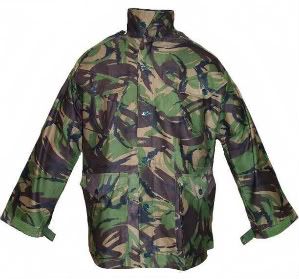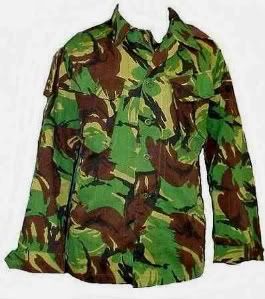After 1968 - the 1985 Pattern
| Jacket - Combat DPM | |

|
A major faux pas on the kitting front. '85 pattern jackets and smocks were of an inferior design to their predecessors and were directly responsible for the decision to get the next choice of combat suit right.
Both the jacket and trousers featured ridiculous bellows pockets that the substandard manufacture ensured fell apart after minimal usage. '85 pattern is best forgotten.
1990 Pattern
The jacket and trousers are recognisable by the use of large pocket buttons with extra zipped pockets on the jacket and no storm flap. These were not lined but still made from more improved material than their '85 pattern predecessors. Somewhat short-lived they did however lead to the current CS95 system.
DPM Tropical Suit
| Jacket - Combat Tropical | |

|
The tropical/jungle DPM suit was also introduced, replacing the tropical OG uniform worn in Malaya and Borneo. This was unlined, and made of a lighter cotton fabric. The 'Trousers, Combat (Tropical)' had both zip and button fly (presumably to offer greater protection for all concerned), belt loops (though no braces buttons), a pyjama-style waist cord and a draw-tape at each ankle.
They had conventional slash pockets at each hip, a buttoned flap pocket at the right rear and another, deeper and gusseted, patch pocket on each thigh. The jacket had both zip and button closure, epaulettes, buttoned cuffs and two gusseted (bellows) patch pockets - basically a camouflaged shirt. This is still in use - although of significantly darker colouration to the bright pattern of the '70s and '80s.
Image courtesy M&G.
Canadian Para Smock
The Canadian Para Smock is very different from the British DPM version. It is made of a nylon and is a much paler DPM with the sand and green elements reversed. It is closed by a bright brass two-way zipper. Cuffs close with 'lift the dot' fasteners as do the bellows mag-sized chest pockets and lower grenade pockets that also have elastic like the old '60 pattern jackets. The tail-piece has lift the dots and closes on three pairs of female closures at the front groin. There is also a poachers pocket closing by a small two-way zip accessible from the outside. Generally these smocks were only worn around barracks.
The Way Ahead
The 1990s saw a wider application of DPM, mainly due to advances in manufacturing and production. The most noticeable development was that of the desert pattern material. Though desert pattern DPM was trialed in the early 1980s, it wasn't until the Gulf War of 1990 that its use became widespread. The Gulf pattern DPM was of slightly different design that its trial predecessor - expediency and economy dictating a simpler two-colour pattern than that previously trialed. The basic tropical suit, hat, helmet and body armour cover was thus manufactured in this material and mass produced in haste.
Since then, DPM has appeared on PLCE and bergens - something that would have been unimaginable for general issue just a few years previous due to the cost of production. The sheer variety of specialist clothing such as Gore-Tex coveralls is staggering compared to what was available twenty years ago - and in both desert and temperate guises.
What does the future hold? DPM is likely to be superseded by a digital pattern as part of the current PECOC Programme - a trend that is gaining momentum in several countries' armed forces, notably the US. Then it's only a matter of time before the 'original & best' camouflage pattern is consigned to the history bin.
没有评论:
发表评论